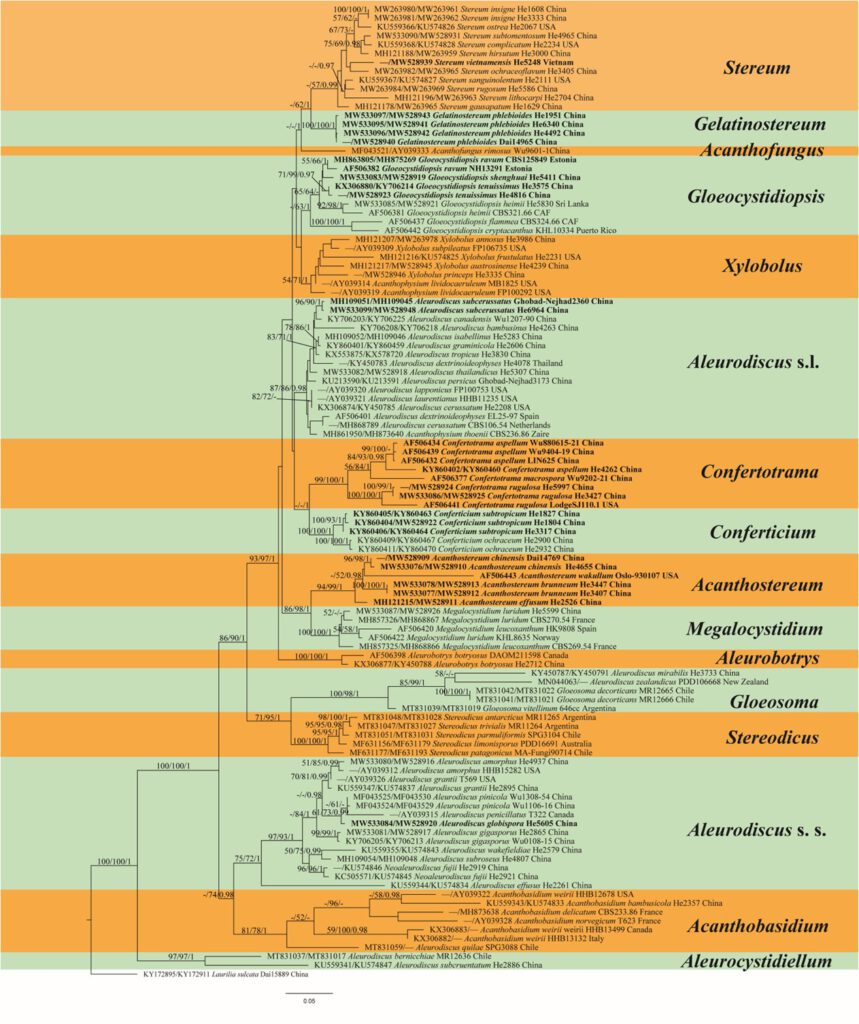Annarosaea Nakasone & S.H. He, gen. nov.
MycoBank number: MB; Index Fungorum number: IF; Facesoffungi number: FoF 12561;
(Descriptions of sexual and asexual states of the genus)
Sexual state: Fruiting body – Basidiomata annual, resupinate, effused, closely adnate, subceraceous to crustose. Hymenophore smooth or tuberculate, yellow, orange to ochraceous, uncracked or densely cracked with age; margin determinate, abrupt or thinning out, sometimes loosening from the substrate, paler or concolorous with hymenophore. Context yellowish white, with compact and agglutinated texture.
Microscopic structures – Hyphal system monomitic; all hyphae with clamps, colorless, thin- to slightly thick-walled, smooth, rarely branched, moderately septate. Gloeocystidia numerous, vesicular, tubular to subulate, large, thin- to thick-walled, smooth, often with yellowish liquid contents, turning bluish black in sulphovanillin, embedded or slightly projecting beyond the hymenium. Basidia clavate, colorless, thin-walled, smooth, with four sterigmata and a basal clamp. Basidiospores ellipsoid, oblong ellipsoid to cylindrical, colorless, thin-walled, smooth or ornamented, distinctly amyloid, acyanophilous.
Asexual state: not observed.
Type species: Annarosaea rugulosa (Berk. & M.A. Curtis) Nakasone & S.H. He
Notes: Our phylogenetic analyses also recovered this lineage (Fig. 1). Morphologically, those species have some similar characteristic features, such as, yellowish basidiomata with compact texture, clamped generative hyphae and numerous large gloeocystidia with a sulphovanillin reaction. Basidiospores are reported as smooth in M. chelidonium and verrucose in G. aspellum but also as ‘indistinctly verrucose or seemingly smooth’ in B. macrospora (Wu 1996; Boidin et al. 1997). Meanwhile, there aren’t other morphological differences can be used to separate M. chelidonium from other species in this lineage. Thus, at present, we treat this lineage as a single genus and propose the new generic name Annarosaea for it..
Importance and role:
Importance of genus to humans or ecosystem Not found
Industrial relevance and applications Not found
Quarantine significance Not found
Biochemical importance of the genus, chemical diversity or applications Not found
Phylogenetic placement of genus Annarosaea
Species list
Annarosaea aspera (Hjortstam) Nakasone & S.H. He, comb. nov.
Annarosaea rugulosa (Berk. & M.A. Curtis) Nakasone & S.H. He, comb. nov.
Annarosaea macrospora (Sheng H. Wu) Nakasone & S.H. He, comb. nov.
Annarosaea rajchenbergii (Gorjón & Hallenb.) Nakasone & S.H. He, comb. nov.

Fig. 1. Phylogenetic tree obtained from maximum parsimony analysis of ITS and nrLSU sequence data of Stereaceae. Branches are labelled with parsimony bootstrap values (≥ 50%, front), likelihood bootstrap values (≥ 50%, middle) and Bayesian posterior probabilities (≥ 0.95, back). New taxa are shown in bold.
Species
